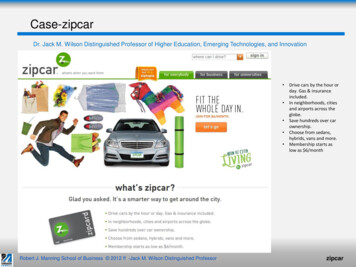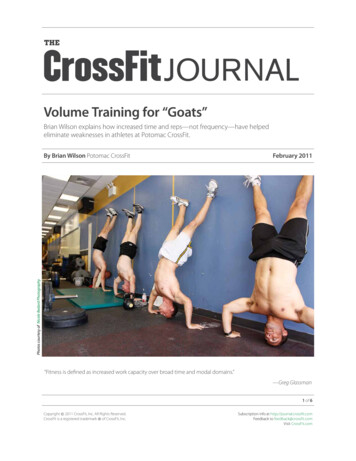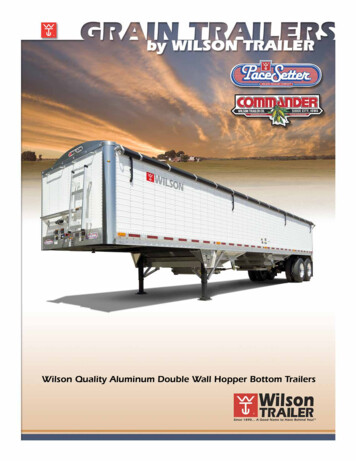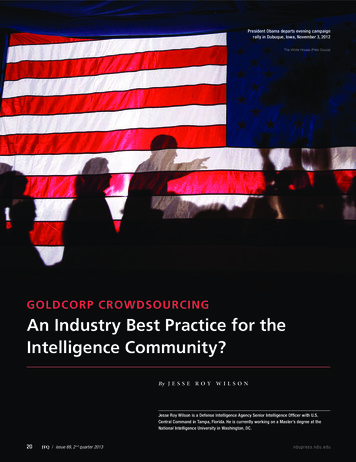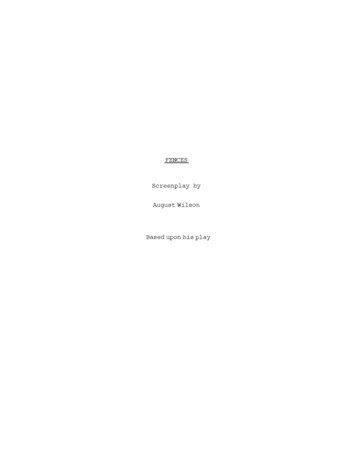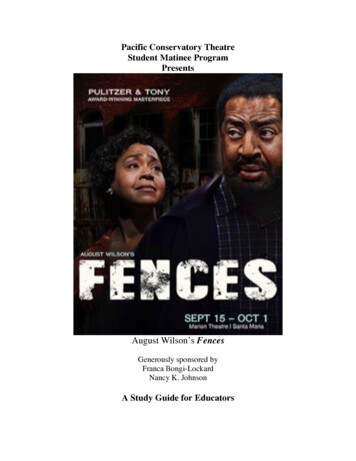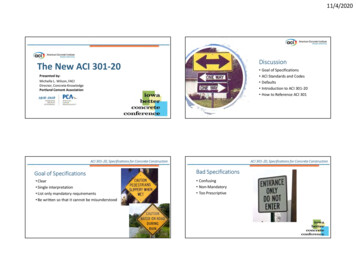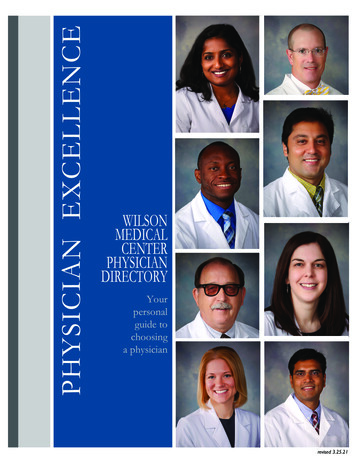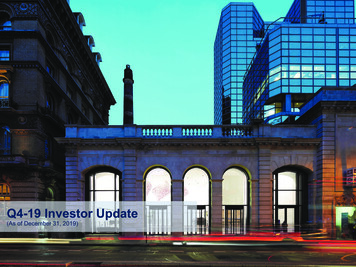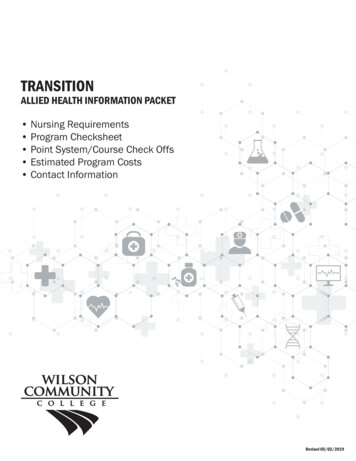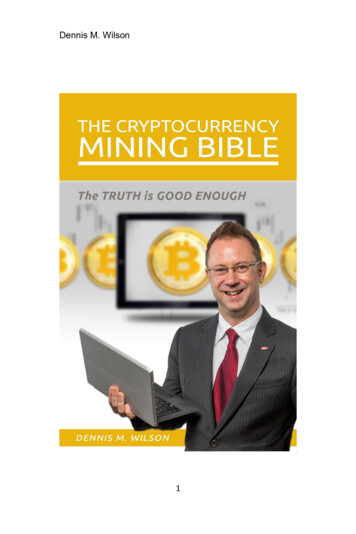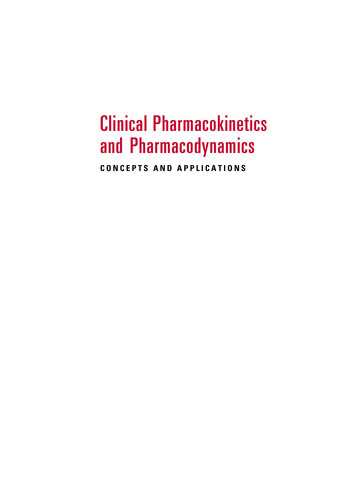
Transcription
000i-000x 17865 FM.qxd12/2/092:49 AMPage iWilson and Gisvold’sTextbook ofORGANIC MEDICINALAND PHARMACEUTICALCHEMISTRYTWELFTHEDIEdited byJohn M. Beale, Jr., PhDAssociate Professor of Medicinal ChemistryDivision of Basic and Pharmaceutical SciencesSt. Louis College of PharmacySaint Louis, MissouriJohn H. Block, PhD, RPhProfessor Emeritus, Medicinal ChemistryDepartment of Pharmaceutical SciencesCollege of PharmacyOregon State UniversityCorvallis, OregonTION
000i-000x 17865 FM.qxd12/2/092:49 AMPage iiEditor: David B. TroyProduct Manager: Meredith L. BrittainVendor Manager: Kevin JohnsonDesigner: Holly McLaughlinCompositor: Absolute Service, Inc./Maryland Composition12th EditionCopyright 2011 by Lippincott Williams & Wilkins, a Wolters Kluwer business.First Edition, 1949Second Edition, 1954Third Edition, 1956Fourth Edition, 1962Fifth Edition, 1966Sixth Edition, 1971Seventh Edition, 1977Eighth Edition, 1982351 West Camden StreetBaltimore, MD 21201530 Walnut StreetPhiladelphia, PA 19106Ninth Edition, 1991Tenth Edition, 1998Eleventh Edition, 2004Printed in The People’s Republic of ChinaAll rights reserved. This book is protected by copyright. No part of this book may be reproduced or transmittedin any form or by any means, including as photocopies or scanned-in or other electronic copies, or utilized by anyinformation storage and retrieval system without written permission from the copyright owner, except for briefquotations embodied in critical articles and reviews. Materials appearing in this book prepared by individuals aspart of their official duties as U.S. government employees are not covered by the above-mentioned copyright. Torequest permission, please contact Lippincott Williams & Wilkins at 530 Walnut Street, Philadelphia, PA 19106,via email at permissions@lww.com, or via Web site at http://www.lww.com (products and services).9 8 7 6 5 4 3 2 1Library of Congress Cataloging-in-Publication DataWilson and Gisvold’s textbook of organic medicinal and pharmaceutical chemistry. — 12th ed. / edited by JohnM. Beale, Jr., John H. Block.p. ; cm.Includes bibliographical references and index.ISBN 978-0-7817-7929-61. Pharmaceutical chemistry. 2. Chemistry, Organic. I. Wilson, Charles Owens, 1911- II. Beale, John Marlowe.III. Block, John H. IV. Title: Textbook of organic medicinal and pharmaceutical chemistry.[DNLM: 1. Chemistry, Pharmaceutical. 2. Chemistry, Organic. QV 744 W754 2011]RS403.T43 2011615'.19—dc222009043714DISCLAIMERCare has been taken to confirm the accuracy of the information present and to describe generally accepted practices. However, the authors, editors, and publisher are not responsible for errors or omissions or for any consequences from application of the information in this book and make no warranty, expressed or implied, withrespect to the currency, completeness, or accuracy of the contents of the publication. Application of this information in a particular situation remains the professional responsibility of the practitioner; the clinical treatmentsdescribed and recommended may not be considered absolute and universal recommendations.The authors, editors, and publisher have exerted every effort to ensure that drug selection and dosage set forthin this text are in accordance with the current recommendations and practice at the time of publication. However,in view of ongoing research, changes in government regulations, and the constant flow of information relating todrug therapy and drug reactions, the reader is urged to check the package insert for each drug for any change inindications and dosage and for added warnings and precautions. This is particularly important when the recommended agent is a new or infrequently employed drug.Some drugs and medical devices presented in this publication have Food and Drug Administration (FDA)clearance for limited use in restricted research settings. It is the responsibility of the healthcare provider to ascertain the FDA status of each drug or device planned for use in their clinical practice.To purchase additional copies of this book, call our customer service department at (800) 638-3030 or fax ordersto (301) 223-2320. International customers should call (301) 223-2300.Visit Lippincott Williams & Wilkins on the Internet: http://www.lww.com. Lippincott Williams & Wilkins customer service representatives are available from 8:30 am to 6:00 pm, EST.
000i-000x 17865 FM.qxd12/2/092:49 AMPage iiiThe 12th Edition of Wilson and Gisvold’s Textbook of Organic Medicinal and PharmaceuticalChemistry is dedicated to the memory of Robert F. Doerge.Robert F. Doerge1915–2006Robert Doerge—pharmacist, medicinal chemist, and educator—experienced the Depression andserved in the Civilian Conservation Corp in Sheridan, AR. Dr. Doerge received his B.S. in pharmacy in 1943 and his PhD in pharmaceutical chemistry, both from the University of Minnesota in 1949.The latter was under the direction of Dr. Charles O. Wilson, who, with Dr. Ole Gisvold, started thiswell-respected medicinal chemistry textbook. Dr. Doerge began his professional career as an assistantprofessor in the University of Texas-Austin School of Pharmacy before becoming a research chemistwith the former Smith Kline and French Laboratories in Philadelphia. Beginning in 1960, he returnedto academia as professor and chair of the pharmaceutical chemistry department in Oregon StateUniversity’s College of Pharmacy. Prior to his retirement as professor emeritus in 1981, he was theassistant dean.Dr. Doerge’s initial publications were on the topic of synthesis of anticonvulsants. At Smith Klineand French, his work included publications on vitamin stability, and at Oregon State University, his papers focused on the heterocyclic phenylindolizines. Dr. Doerge was a volunteer abstractor for ChemicalAbstracts. As an educator, Dr. Doerge was an author of chapters in Wilson and Gisvold’s Textbook ofOrganic Medicinal and Pharmaceutical Chemistry, coeditor of the 6th and 7th editions, and editor ofthe 8th edition. His skill and dedication in the classroom were recognized by the students and university with several teaching awards.We certainly miss this fine gentleman who put the students first and advanced the teaching of medicinal chemistry as a chapter author, coeditor, and editor of the Wilson and Gisvold textbook series.John H. Blockiii
000i-000x 17865 FM.qxd12/2/092:49 AMPage ivPREFACEFor 6 decades, Wilson and Gisvold’s Textbook of Organic Medicinal and Pharmaceutical Chemistry hasbeen a standard in the literature of medicinal chemistry. Generations of students and faculty have depended on this textbook not only for undergraduate courses in medicinal chemistry but also as a supplement for graduate studies. Moreover, students in other health sciences have found certain chapters useful. The current editors and authors worked on the 12th edition with the objective of continuing thetradition of a modern textbook for undergraduate students and also for graduate students who need ageneral review of medicinal chemistry. Because the chapters include a blend of chemical and pharmacological principles necessary for understanding structure–activity relationships and molecular mechanisms of drug action, the book should be useful in supporting courses in medicinal chemistry and incomplementing pharmacology courses.ABOUT THE 12TH EDITIONThe 12th edition follows in the footsteps of the 11th edition by reflecting the dynamic changes occurring in medicinal chemistry. With increased knowledge of the disease process and the identification of the key steps in the biochemical process, the chapters have been updated, expanded,and reorganized. At the same time, to streamline the presentation of the content, some topics werecombined into existing chapters. For example, Chapter 2, “Drug Design Strategies,” incorporatesmaterial from 11th edition Chapters 2, 3, and 28, and Chapter 3, “Metabolic Changes of Drugs andRelated Organic Compounds,” includes the content from 11th edition Chapter 5, “Prodrugs andDrug Latentiation.” In addition, with the newer drugs that have entered the pharmaceutical armamentarium since publication of the 11th edition, coverage of the following topics has been expanded in the 12th edition: Central Dopaminergic Signaling Agents (Chapter 13), Anticonvulsants(Chapter 14), Hormone-Related Disorders: Nonsteroidal Therapies (Chapter 20), Agents TreatingBone Disorders (Chapter 21), and Anesthetics (Chapter 22).New features of the 12th edition include a chapter overview at the beginning of each chapter to introduce material to be covered in the chapter and review questions at the end of each chapter to reinforce concepts learned in the chapter (answers to these questions are available to students on the book’scompanion Web site; see next section).ADDITIONAL RESOURCESWilson and Gisvold’s Textbook of Organic Medicinal and Pharmaceutical Chemistry, 12th Edition, includes additional resources for both instructors and students that are available on the book’s companionWeb site at proved adopting instructors will be given access to the following additional resources: Image bank of all the figures and tables in the bookStudentsStudents who have purchased Wilson and Gisvold’s Textbook of Organic Medicinal and PharmaceuticalChemistry, 12th Edition, have access to the following additional resources: The answers to the review questions found in the bookIn addition, purchasers of the text can access the searchable Full Text On-line by going to the Wilsonand Gisvold’s Textbook of Organic Medicinal and Pharmaceutical Chemistry, 12th Edition, Web siteat http://www.thePoint.lww.com/Beale12e. See the inside front cover of this text for more details,including the passcode you will need to gain access to the Web site.iv
000i-000x 17865 FM.qxd12/2/092:49 AMPage vPreface vACKNOWLEDGMENTSThe editors welcome the new contributors to the 12th edition: Jeffrey J. Christoff, A. Michael Crider,Carolyn J. Friel, Ronald A. Hill, Shengquan Liu, Matthias C. Lu, Marcello J. Nieto, and Kenneth A.Witt. The editors extend thanks to all of the authors who have cooperated in the preparation of the current edition. Collectively, the authors represent many years of teaching and research experience in medicinal chemistry. Their chapters include summaries of current research trends that lead the reader to theoriginal literature. Documentation and references continue to be an important feature of the book.We continue to be indebted to Professors Charles O. Wilson and Ole Gisvold, the originators of thebook and editors of five editions, Professor Robert Doerge, who joined Professors Wilson and Gisvoldfor the 6th and 7th editions and single-handedly edited the 8th edition, and Professors Jaime Delgado andWilliam Remers, who edited the 9th and 10th editions. They and the authors have contributed significantly to the education of countless pharmacists, medicinal chemists, and other pharmaceutical scientists.John M. Beale, Jr.John H. Block1st19492nd3rd4th5th1954195619621966Wilson and Gisvold (OrganicChemistry in Pharmacy)Wilson and GisvoldWilsonWilson and 9982004Wilson, Gisvold, and DoergeWilson, Gisvold, and DoergeDoergeDelgado and RemersDelgado and RemersBlock and Beale
000i-000x 17865 FM.qxd12/2/092:49 AMPage viCONTRIBUTORSJohn M. Beale, Jr., PhDAssociate Professor of MedicinalChemistryDivision of Basic and PharmaceuticalSciencesSt. Louis College of PharmacySaint Louis, MissouriJohn H. Block, PhD, RPhMichael J. Deimling,RPh, PhDDepartment of PharmaceuticalSciencesSchool of PharmacyGeorgia Campus—PhiladelphiaCollege of Osteopathic MedicineSuwanee, GeorgiaProfessor Emeritus, MedicinalChemistryDepartment of PharmaceuticalSciencesCollege of PharmacyOregon State UniversityCorvallis, OregonJack DeRuiter, MS, PhDJeffrey J. Christoff,Carolyn J. Friel,PhD, RPhProfessorDepartment of Pharmaceuticaland Biomedical SciencesCollege of Pharmacy, Ohio NorthernUniversityAda, OhioC. Randall Clark, PhDProfessorDepartment of PharmaceuticalSciencesAuburn University School ofPharmacyAuburn, AlabamaA. Michael Crider, PhDChair and ProfessorDepartment of PharmaceuticalSciencesSouthern Illinois UniversityEdwardsvilleEdwardsville, IllinoisHorace G. Cutler, PhDSenior Research ProfessorCollege of Pharmacy and HealthSciencesMercer UniversityAtlanta, GeorgiaStephen J. CutlerChair and ProfessorDepartment of Medicinal ChemistryUniversity of MississippiOxford, MississippiviProfessorDepartment of PharmaceuticalSciencesAuburn University School ofPharmacyAuburn, AlabamaRPh, PhDAssociate Professor of MedicinalChemistryDepartment of PharmaceuticalSciencesMassachusetts College of Pharmacyand Health Sciences—WorcesterWorcester, MassachusettsRonald A. Hill, PhDAssociate ProfessorDepartment of Basic PharmaceuticalSciencesThe University of Louisiana atMonroeMonroe, LouisianaThomas J. Holmes, Jr.,PhDProfessorDepartment of PharmaceuticalSciencesCampbell University College ofPharmacy and the Health SciencesBuies Creek, New CarolinaM. O. Faruk Khan,BPharm, MPharm, PhDAssistant Professor of MedicinalChemistryDepartment of PharmaceuticalSciencesSouthwestern Oklahoma StateUniversity College of PharmacyWeatherford, OklahomaMatthias C. Lu, PhDProfessor and Assistant Head forCurricular AffairsDepartment of Medicinal Chemistryand PharmacognosyCollege of Pharmacy, University ofIllinois at ChicagoChicago, IllinoisShengquan Liu, PhDAssistant ProfessorDepartment of Medicinal ChemistryTouro University—CaliforniaVallejo, CaliforniaMarcello J. Nieto, PhDAssistant ProfessorDepartment of PharmaceuticalSciencesSouthern Illinois UniversityEdwardsville, IllinoisGustavo R. Ortega,RPh, PhDProfessor EmeritusDepartment of PharmaceuticalSciencesSouthwestern Oklahoma StateUniversity College of PharmacyWeatherford, OklahomaPhilip J. Proteau, PhDAssociate Professor of MedicinalChemistryDepartment of PharmaceuticalSciencesOregon State University College ofPharmacyCorvallis, OregonForrest T. Smith, PhDAssociate ProfessorDepartment of PharmaceuticalSciencesAuburn University School ofPharmacyAuburn, AlabamaKenneth A. Witt, PhDAssistant ProfessorDepartment of PharmaceuticalSciencesSouthern Illinois UniversityEdwardsvilleEdwardsville, Illinois
000i-000x 17865 FM.qxd12/2/092:50 AMPage viiCONTENTSPreface . . . . . . . . . . . . . . . . . . . . . . . . . . . . . . . . . . . . . . . . ivContributors . . . . . . . . . . . . . . . . . . . . . . . . . . . . . . . . . . . . viCHAPTERAntisense Technology . . . . . . . . . . . . . . . . . . . . . . 152Gene Therapy . . . . . . . . . . . . . . . . . . . . . . . . . . . . . 153Afterword . . . . . . . . . . . . . . . . . . . . . . . . . . . . . . . . 1531Introduction . . . . . . . . . . . . . . . . . . . . . . 1John M. Beale, Jr. and John H. BlockCHAPTER5Immunobiologicals . . . . . . . . . . . . . . . 156John M. Beale, Jr.CHAPTER2Drug Design Strategies . . . . . . . . . . . . . 3John H. BlockDrug Distribution . . . . . . . . . . . . . . . . . . . . . . . . . . . . 3Acid–Base Properties . . . . . . . . . . . . . . . . . . . . . . . . 12Computer-Aided Drug Design: Early Methods . . . 17Computer-Aided Drug Design: Newer Methods . . 25Selected Web Pages . . . . . . . . . . . . . . . . . . . . . . . . . 40Cells of the Immune System . . . . . . . . . . . . . . . . . 156Immunity . . . . . . . . . . . . . . . . . . . . . . . . . . . . . . . . 159Acquistion of Immunity . . . . . . . . . . . . . . . . . . . . . 165New Vaccine Technologies: AdjuvantTechnology . . . . . . . . . . . . . . . . . . . . . . . . . . . . . 174New Vaccine Technologies: Nucleic AcidVaccines . . . . . . . . . . . . . . . . . . . . . . . . . . . . . . . 177CHAPTER6Anti-infective Agents . . . . . . . . . . . . . 179CHAPTER3Metabolic Changes of Drugsand Related Organic Compounds . . . . 43Stephen J. Cutler and John H. BlockGeneral Pathways of Drug Metabolism . . . . . . . . . 43Sites of Drug Biotransformation. . . . . . . . . . . . . . . 45Role of Cytochrome P450 Monooxygenasesin Oxidative Biotransformations . . . . . . . . . . . . . 45Oxidative Reactions . . . . . . . . . . . . . . . . . . . . . . . . . 47Reductive Reactions . . . . . . . . . . . . . . . . . . . . . . . . . 78Hydrolytic Reactions . . . . . . . . . . . . . . . . . . . . . . . . 86Phase II or Conjugation Reactions . . . . . . . . . . . . . 88Factors Affecting Drug Metabolism . . . . . . . . . . . 104CHAPTER4John M. Beale, Jr.Evaluation of the Effectiveness of a Sterilant . . . 180Alcohols and Related Compounds . . . . . . . . . . . . 181Phenols and Their Derivatives. . . . . . . . . . . . . . . . 183Oxidizing Agents . . . . . . . . . . . . . . . . . . . . . . . . . . 185Halogen-Containing Compounds . . . . . . . . . . . . . 185Cationic Surfactants . . . . . . . . . . . . . . . . . . . . . . . . 186Dyes. . . . . . . . . . . . . . . . . . . . . . . . . . . . . . . . . . . . . 188Mercury Compounds (Mercurials). . . . . . . . . . . . . 189Preservatives . . . . . . . . . . . . . . . . . . . . . . . . . . . . . . 190Antifungal Agents . . . . . . . . . . . . . . . . . . . . . . . . . 191Synthetic Antibacterial Agents . . . . . . . . . . . . . . . 206Antiprotozoal Agents . . . . . . . . . . . . . . . . . . . . . . 220Anthelmintics . . . . . . . . . . . . . . . . . . . . . . . . . . . . . 224Antiscabious and Antipedicular Agents . . . . . . . . 227Antibacterial Sulfonamides . . . . . . . . . . . . . . . . . . 228Dihydrofolate Reductase Inhibitors . . . . . . . . . . . 239Sulfones . . . . . . . . . . . . . . . . . . . . . . . . . . . . . . . . . 239Biotechnology and Drug Discovery. . 119John M. Beale, Jr.Biotechnology and Pharmaceutical Care . . . . . . . 119Literature of Biotechnology . . . . . . . . . . . . . . . . . 119Biotechnology and New Drug Development . . . . 119The Biotechnology of Recombinant DNA . . . . . . 121Some Types of Cloning . . . . . . . . . . . . . . . . . . . . . 126Expression of Cloned DNA . . . . . . . . . . . . . . . . . . 127Manipulation of DNA Sequence Information . . . 127New Biological Targets for Drug Development. . 128Novel Drug-Screening Strategies . . . . . . . . . . . . . 129Processing of the Recombinant Protein . . . . . . . . 131Pharmaceutics of RecombinantDNA-Produced Agents. . . . . . . . . . . . . . . . . . . . 131Delivery and Pharmacokineticsof Biotechnology Products . . . . . . . . . . . . . . . . 134Recombinant Drug Products . . . . . . . . . . . . . . . . . 134The Interleukins . . . . . . . . . . . . . . . . . . . . . . . . . . . 141Enzymes . . . . . . . . . . . . . . . . . . . . . . . . . . . . . . . . . 142Vaccines . . . . . . . . . . . . . . . . . . . . . . . . . . . . . . . . . 145Preparation of Antibodies. . . . . . . . . . . . . . . . . . . 146Genomics . . . . . . . . . . . . . . . . . . . . . . . . . . . . . . . . 150CHAPTER7Antimalarials . . . . . . . . . . . . . . . . . . . 242John H. BlockStimulation of Antimalarial Research by War . . . 245Cinchona Alkaloids . . . . . . . . . . . . . . . . . . . . . . . . 245CHAPTER8Antibacterial Antibiotics. . . . . . . . . . . 258John M. Beale, Jr.Historical Background . . . . . . . . . . . . . . . . . . . . . . 258Current Status . . . . . . . . . . . . . . . . . . . . . . . . . . . . 259Commercial Production . . . . . . . . . . . . . . . . . . . . . 259Spectrum of Activity . . . . . . . . . . . . . . . . . . . . . . . 259Mechanisms of Action . . . . . . . . . . . . . . . . . . . . . . 259Chemical Classification . . . . . . . . . . . . . . . . . . . . . 260Microbial Resistance . . . . . . . . . . . . . . . . . . . . . . . 260 -Lactam Antibiotics . . . . . . . . . . . . . . . . . . . . . . . 260vii
000i-000x 17865 FM.qxd12/2/092:50 AMPage viiiviii ContentsThe Penicillins. . . . . . . . . . . . . . . . . . . . . . . . . . . . . 261 -Lactamase Inhibitors. . . . . . . . . . . . . . . . . . . . . . 274Cephalosporins . . . . . . . . . . . . . . . . . . . . . . . . . . . . 278Monobactams. . . . . . . . . . . . . . . . . . . . . . . . . . . . . 293Aminoglycosides . . . . . . . . . . . . . . . . . . . . . . . . . . 294Tetracyclines . . . . . . . . . . . . . . . . . . . . . . . . . . . . . . 301Macrolides . . . . . . . . . . . . . . . . . . . . . . . . . . . . . . . 308Lincomycins . . . . . . . . . . . . . . . . . . . . . . . . . . . . . . 313Polypeptides . . . . . . . . . . . . . . . . . . . . . . . . . . . . . . 315Unclassified Antibiotics . . . . . . . . . . . . . . . . . . . . . 320Newer Antibiotics . . . . . . . . . . . . . . . . . . . . . . . . . 324New Directions in Antibiotic Discovery . . . . . . . . 326CHAPTERJohn M. Beale, Jr.The Classification and Biochemistry of Viruses . . 330Classification of Viruses . . . . . . . . . . . . . . . . . . . . . 330Targets for the Prevention of ViralInfections—Chemoprophylaxis . . . . . . . . . . . . . 331The Infectious Process for a Virus . . . . . . . . . . . . . 333Nucleoside Antimetabolites: Inhibiting ViralReplication . . . . . . . . . . . . . . . . . . . . . . . . . . . . . 339Newer Agents for the Treatment ofHIV Infection . . . . . . . . . . . . . . . . . . . . . . . . . . . 34610Antineoplastic Agents. . . . . . . . . . . . . 355Forrest T. Smith and C. Randall ClarkIntroduction . . . . . . . . . . . . . . . . . . . . . . . . . . . . . . 355Drug Classes . . . . . . . . . . . . . . . . . . . . . . . . . . . . . . 358Antimetabolites . . . . . . . . . . . . . . . . . . . . . . . . . . . 372Antibiotics and Natural Products . . . . . . . . . . . . . 383Protein Kinase Inhibitors . . . . . . . . . . . . . . . . . . . . 400Miscellaneous Compounds . . . . . . . . . . . . . . . . . . 406CHAPTERJeffrey J. ChristoffRadiopharmaceuticals . . . . . . . . . . . . . . . . . . . . . . 413Contrast Agents . . . . . . . . . . . . . . . . . . . . . . . . . . . 43012Central Nervous SystemDepressants . . . . . . . . . . . . . . . . . . . . . 443Shengquan LiuAnxiolytic, Sedative, and Hypnotic Agents . . . . . 443Antipsychotics . . . . . . . . . . . . . . . . . . . . . . . . . . . . 457Acknowledgment . . . . . . . . . . . . . . . . . . . . . . . . . 469CHAPTER14Anticonvulsants . . . . . . . . . . . . . . . . . 491Matthias C. LuDisease States Requiring AnticonvulsantTherapy . . . . . . . . . . . . . . . . . . . . . . . . . . . . . . . . 491Mechanisms of Action of Anticonvulsants . . . . . . 492Clinically Important Anticonvulsants . . . . . . . . . . 494Future Development of Antiepileptic Drugs . . . . 501CHAPTER15Central Nervous SystemStimulants . . . . . . . . . . . . . . . . . . . . . . 504John M. Beale, Jr.Analeptics . . . . . . . . . . . . . . . . . . . . . . . . . . . . . . . . 504Methylxanthines . . . . . . . . . . . . . . . . . . . . . . . . . . 505Central Sympathomimetic Agents(Psychomotor Stimulants) . . . . . . . . . . . . . . . . . 506Antidepressants . . . . . . . . . . . . . . . . . . . . . . . . . . . 509Miscellaneous CNS-Acting Drugs . . . . . . . . . . . . . 515CHAPTER16Adrenergic Agents . . . . . . . . . . . . . . . 519Shengquan LiuAdrenergic Neurotransmitters . . . . . . . . . . . . . . . 519Adrenergic Receptors . . . . . . . . . . . . . . . . . . . . . . 524Drugs Affecting AdrenergicNeurotransmission . . . . . . . . . . . . . . . . . . . . . . . 528Sympathomimetic Agents . . . . . . . . . . . . . . . . . . . 531Adrenergic Receptor Antagonists (Blockers) . . . . 545Acknowledgment . . . . . . . . . . . . . . . . . . . . . . . . . 55411Agents for Diagnostic Imaging . . . . . 413CHAPTERCHAPTER9Antiviral Agents . . . . . . . . . . . . . . . . . 330CHAPTERAntipsychotic Drugs . . . . . . . . . . . . . . . . . . . . . . . . 478Future Directions . . . . . . . . . . . . . . . . . . . . . . . . . . 48813Central DopaminergicSignaling Agents. . . . . . . . . . . . . . . . . 471A. Michael Crider, Marcelo J. Nieto, and Kenneth A. WittDopamine . . . . . . . . . . . . . . . . . . . . . . . . . . . . . . . . 471Parkinson Disease. . . . . . . . . . . . . . . . . . . . . . . . . . 473CHAPTER17Cholinergic Drugs and RelatedAgents . . . . . . . . . . . . . . . . . . . . . . . . . 558Stephen J. CutlerCholinergic Receptors . . . . . . . . . . . . . . . . . . . . . . 559Cholinergic Neurochemistry . . . . . . . . . . . . . . . . . 563Cholinergic Agonists . . . . . . . . . . . . . . . . . . . . . . . 564Cholinergic Receptor Antagonists . . . . . . . . . . . . 567Cholinergic Blocking Agents . . . . . . . . . . . . . . . . . 581Parasympathetic PostganglionicBlocking Agents . . . . . . . . . . . . . . . . . . . . . . . . . 583Solanaceous Alkaloids and Analogs . . . . . . . . . . . 584Synthetic Cholinergic Blocking Agents. . . . . . . . . 588Ganglionic Blocking Agents . . . . . . . . . . . . . . . . . 596Neuromuscular Blocking Agents. . . . . . . . . . . . . . 599CHAPTER18Drugs Acting on the Renal System . . 607Stephen J. CutlerRenin–Angiotensin System Inhibitors . . . . . . . . . . 609ACE-Inhibitor Prodrugs . . . . . . . . . . . . . . . . . . . . . 610Angiotensin Antagonists . . . . . . . . . . . . . . . . . . . . 612
000i-000x 17865 FM.qxd12/2/092:50 AMPage ixContentsAngiotensin II Blockers . . . . . . . . . . . . . . . . . . . . . 613Renin Inhibitors . . . . . . . . . . . . . . . . . . . . . . . . . . . 614Aldosterone Antagonists. . . . . . . . . . . . . . . . . . . . 615CHAPTERixRecent Antihistamine Developments:the “Dual-Acting” Antihistamines . . . . . . . . . . 759Histamine H2-Antagonists . . . . . . . . . . . . . . . . . . . 760Histamine H3- and H4-ReceptorLigands . . . . . . . . . . . . . . . . . . . . . . . . . . . . . . . . 77319Cardiovascular Agents . . . . . . . . . . . . 617Stephen J. CutlerAntianginal Agents and Vasodilators. . . . . . . . . . 617Antiarrhythmic Drugs . . . . . . . . . . . . . . . . . . . . . . 629Antihypertensive Agents . . . . . . . . . . . . . . . . . . . . 637Antihyperlipidemic Agents . . . . . . . . . . . . . . . . . . 647Anticoagulants . . . . . . . . . . . . . . . . . . . . . . . . . . . . 654Synthetic Hypoglycemic Agents . . . . . . . . . . . . . . 658Thyroid Hormones . . . . . . . . . . . . . . . . . . . . . . . . . 663Antithyroid Drugs . . . . . . . . . . . . . . . . . . . . . . . . . 663CHAPTERRonald A. HillDisorders of Glucose Metabolism: Diabetesand the Metabolic Syndrome . . . . . . . . . . . . . . 666Gonadotropins, Gonadotrpoin-ReleasingHormone, and GNRH Receptor Agonistsand Antagonists . . . . . . . . . . . . . . . . . . . . . . . . . 695Concluding Remarks . . . . . . . . . . . . . . . . . . . . . . . 70121Agents Treating Bone Disorders . . . . 705John H. BlockDiseases of Bone Tissue Utilizing ApprovedDrug Therapies. . . . . . . . . . . . . . . . . . . . . . . . . . 705Drugs Used to Treat Diseases ofthe Bone . . . . . . . . . . . . . . . . . . . . . . . . . . . . . . . 706Hormone Therapy . . . . . . . . . . . . . . . . . . . . . . . . . 708Future Directions . . . . . . . . . . . . . . . . . . . . . . . . . . 710CHAPTERCarolyn J. Friel and Matthias C. LuPain and Pain Management . . . . . . . . . . . . . . . . . 776Opioids . . . . . . . . . . . . . . . . . . . . . . . . . . . . . . . . . . 777Drug Monographs . . . . . . . . . . . . . . . . . . . . . . . . . 782Nonsteroidal Anti-inflammatory Drugs . . . . . . . . 792Disease-Modifying Antirheumatic Drugs . . . . . . . 806Drugs Used in the Management of Goutand Hyperuricemia. . . . . . . . . . . . . . . . . . . . . . . 809Triptans . . . . . . . . . . . . . . . . . . . . . . . . . . . . . . . . . . 811CHAPTER25Steroid Hormones andTherapeutically RelatedCompounds . . . . . . . . . . . . . . . . . . . . . 819Philip J. ProteauSteroid Nomenclature, Stereochemistry,and Numbering . . . . . . . . . . . . . . . . . . . . . . . . . 819Steroid Biosynthesis . . . . . . . . . . . . . . . . . . . . . . . . 819Chemical and Physical Properties of Steroids . . . 822Changes to Modify PharmacokineticProperties of Steroids . . . . . . . . . . . . . . . . . . . . 822Steroid Hormone Receptors . . . . . . . . . . . . . . . . . 823Gonadotropin-Releasing Hormoneand Gonadotropins . . . . . . . . . . . . . . . . . . . . . . 826Sex Hormones. . . . . . . . . . . . . . . . . . . . . . . . . . . . . 827Chemical Contraceptive Agents . . . . . . . . . . . . . . 841Androgens . . . . . . . . . . . . . . . . . . . . . . . . . . . . . . . 847Adrenal Cortex Hormones. . . . . . . . . . . . . . . . . . . 853Neurosteroids . . . . . . . . . . . . . . . . . . . . . . . . . . . . . 864Acknowledgment. . . . . . . . . . . . . . . . . . . . . . . . . . 86422Anesthetics . . . . . . . . . . . . . . . . . . . . . 711Carolyn J. FrielThe Inhaled General Anesthetics . . . . . . . . . . . . . 711The Injectable General Anesthetics . . . . . . . . . . . 716The Local Anesthetics . . . . . . . . . . . . . . . . . . . . . . 718Local Anesthetic Monographs, IndividualProducts Including Adverse Reactions . . . . . . . 725CHAPTER24Analgesics . . . . . . . . . . . . . . . . . . . . . . 77620Hormone-Related Disorders:Nonsteroidal Therapies . . . . . . . . . . . 666CHAPTERCHAPTER23Histamine and AntihistaminicAgents . . . . . . . . . . . . . . . . . . . . . . . . . 733Jack DeRuiterHistamine Chemistry . . . . . . . . . . . . . . . . . . . . . . . 733Histamine as a Chemical Messenger. . . . . . . . . . . 733Antihistamines . . . . . . . . . . . . . . . . . . . . . . . . . . . . 737Inhibition of Histamine Release: Mast CellStabilizers . . . . . . . . . . . . . . . . . . . . . . . . . . . . . . 757CHAPTER26Prostaglandins, Leukotrienes,and Essential Fatty Acids. . . . . . . . . . 868Thomas J. Holmes, Jr.Essential Fatty Acids. . . . . . . . . . . . . . . . . . . . . . . . 868History of Eicosanoid Discovery . . . . . . . . . . . . . . 868Eicosanoid Biosynthesis . . . . . . . . . . . . . . . . . . . . . 869Drug Action Mediated by Eicosanoids . . . . . . . . . 872COX-2 Inhibitors. . . . . . . . . . . . . . . . . . . . . . . . . . . 872Design of Eicosanoid Drugs. . . . . . . . . . . . . . . . . . 872Eicosanoid Receptors . . . . . . . . . . . . . . . . . . . . . . . 875Commerci
The 12th Edition ofWilson and Gisvold’s Textbook of Organic Medicinal and Pharmaceutical Chemistry is dedicated to the memory of Robert F.Doerge. Robert F. Doerge 1915–2006 R obert Doerge—pharmacist, medic
